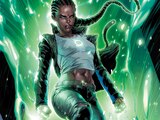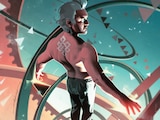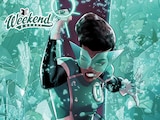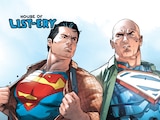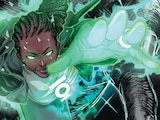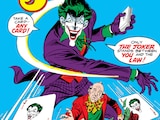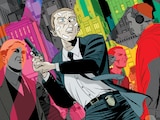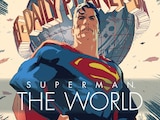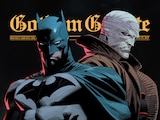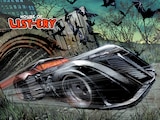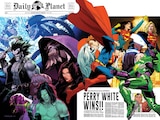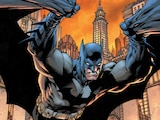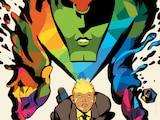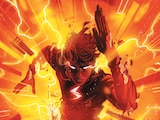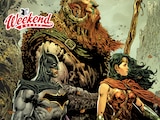Jack Kirby’s Fourth World is the corner of the DC Universe I would most like to spend time in—so long as I don’t have to go to Apokolips for too long. Across the pages of Superman’s Pal, Jimmy Olsen, Mister Miracle, New Gods and The Forever People in the early 1970s, Kirby constructed an entirely new mythos within the DC Universe. With his pantheon of New Gods, he introduced a long and bitter history for two planets beyond space and time called New Genesis and Apokolips. Ruled by wise Highfather and tyrannical Darkseid, respectively, the feud between these worlds was paused when their leaders traded sons. With Darkseid’s warlike child, Orion, to be raised by gentle Highfather, and Highfather’s infant son, the escape artist who would later become Mister Miracle, doomed to the fires of Darkseid’s Apokolips, the stage was set for the operatic drama of Jack Kirby’s Fourth World Saga.
Recently, Ram V and Evan Cagle launched an updated New Gods series featuring all of our favorite characters from the Fourth World and then some. With the grand return of Orion, Mister Miracle, Barda, Metron and the rest of Kirby’s pantheon to an ongoing series, let’s take a look back at some of the influences that shaped the legendary comic book creator’s original vision of the Fourth World. I won’t pretend that I can capture the full spectrum of Kirby’s influences for his Fourth World Saga here, but if you’d like to read further on it, Old Gods & New: A Companion to Jack Kirby’s Fourth World by John Morrow provides an excellent overview.

Kirby loved classical storytelling—that is, myths and legends—and that interest bleeds over into his work with the New Gods. However, in the mid-twentieth century, Kirby felt that old gods like Thor, who he had previously worked to modernize for contemporary audiences, were inadequate for tackling the problems of his time. The United States and the Soviet Union’s Space Race had well been underway, and Kirby felt that comic books needed mythological figures that could represent the technological innovation, authoritarian evil and desire for peace that defined the twentieth century at that point.
In an interview with Comic & Crypt #5 from 1971, Kirby stated, “We can’t be Thor. We can’t be Odin anymore. We’re not a bunch of guys running around in bear skins; we’re guys that wear spacesuits and surgeon’s masks.”
This led to the creation of Metron, a New God who travels around the cosmos in his Mobius Chair as he seeks answers to the universe’s questions. The name of the character is possibly derived from a group of aliens called “Metrons” featured in episode 18 (“The Arena”) of the first season of Star Trek. Considering that Star Trek was and continues to be forward-thinking, just like Kirby’s work, it’s not surprising that Kirby would include a nod to Gene Roddenberry’s show.

Continuing on with the influence of contemporary technological innovation on Kirby’s Fourth World, Old Gods & New posits that Kirby may have gotten the name for Darkseid’s son, Orion, from NASA’s Project Orion. Project Orion was developed as a spacecraft fueled by nuclear explosions (thankfully, it never took flight). The character of Orion is also known in the Fourth World as the “Dog of War,” a title that refers to the shape of his helmet, the character’s dogged and combative nature, and Kirby’s interest in forging a new mythology. “Dog” is “god” spelled backwards, of course. And even though he had all the might of a classical god like Ares (maybe even more so), Orion doesn’t ride around in a chariot with a sword or shield. He races around the cosmos in a fancy piece of technology called an Astro-Harness, his power emanating from a mysterious entity called the Astro-Force. In his hand, Orion carries around a smartphone-sized device called a Mother Box that calms his fiery Apokoliptian nature and can even change his physical appearance. In the Fourth World, even gods have their own devices.
But what of Orion’s father, Darkseid? With Darkseid, Kirby mapped out the motivations of the leaders he abhorred most in the world: Adolf Hitler and Richard Nixon. In an interview from the Jack Kirby Collector #6, Kirby’s assistant and accomplished comic book writer in his own right, Mark Evanier, explained that “...Darkseid was the flip-side of Kirby. He was the Anti-Kirby. Darkseid was against everything Jack stood for in his life, and the various heroes who opposed Darkseid were all different facets of Jack’s personality.”

For Mister Miracle, the basic idea of the character as an escape artist trying to flee the violence of his living conditions spoke to Kirby’s upbringing on the Lower East Side of Manhattan. But Kirby was also inspired by Harry Houdini as well as his fellow comic book creator Jim Steranko, who had worked as a magician and circus performer in his youth. Mister Miracle’s wife, Big Barda, echoed the height difference between Kirby and his wife, Roz. While Roz wasn’t quite as tall as Barda in real life, it’s clear that Kirby wasn’t afraid to draw inspiration from his personal life with his Fourth World Saga.
Jack Kirby’s greatest works are made up of threads inspired by the world around him, as well as his dreams and predictions about where humanity would go next. There’s so much more that could be extrapolated about where he got his influences from with the Fourth World Saga. The information’s out there if you’d like to discover more…though these are gods. No one would fault you, least of all Kirby himself, for just enjoying what’s there on the page and taking the rest on faith.
The New Gods #2 by Ram V, Evan Cagle, Jesse Lonergan and Francesco Segala hits shops and digital retailers this week. Jack Kirby’s Fourth World Saga can be read in full on DC UNIVERSE INFINITE.
Jules Chin Greene writes about comics, TV, games and film for DC.com, and his work can also be found at Nerdist, Popverse and Multiverse of Color. You can follow him on Bluesky at @JulesChinGreene and on Instagram at @infinitevibes.

